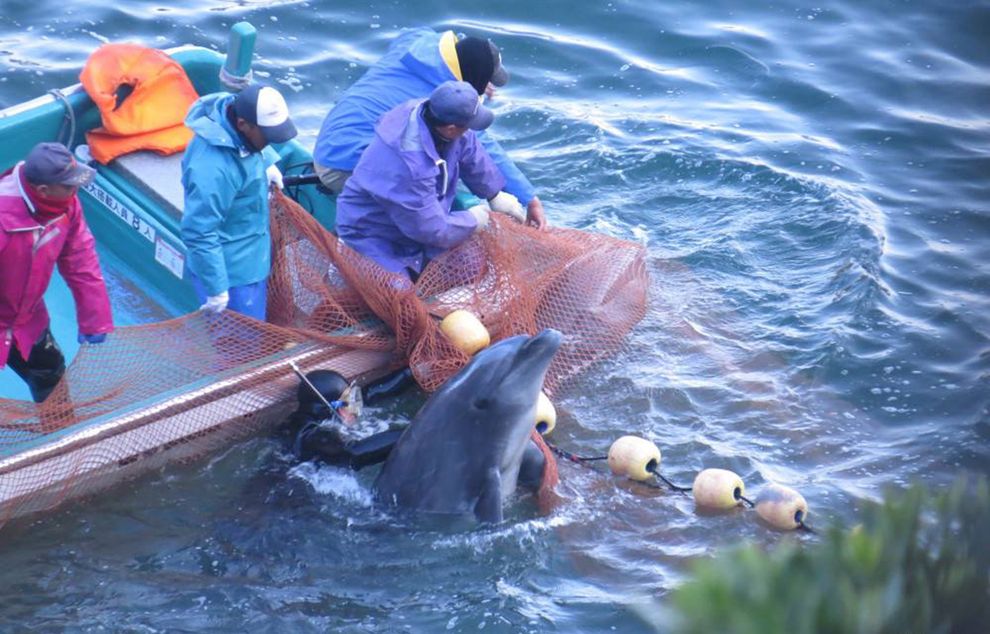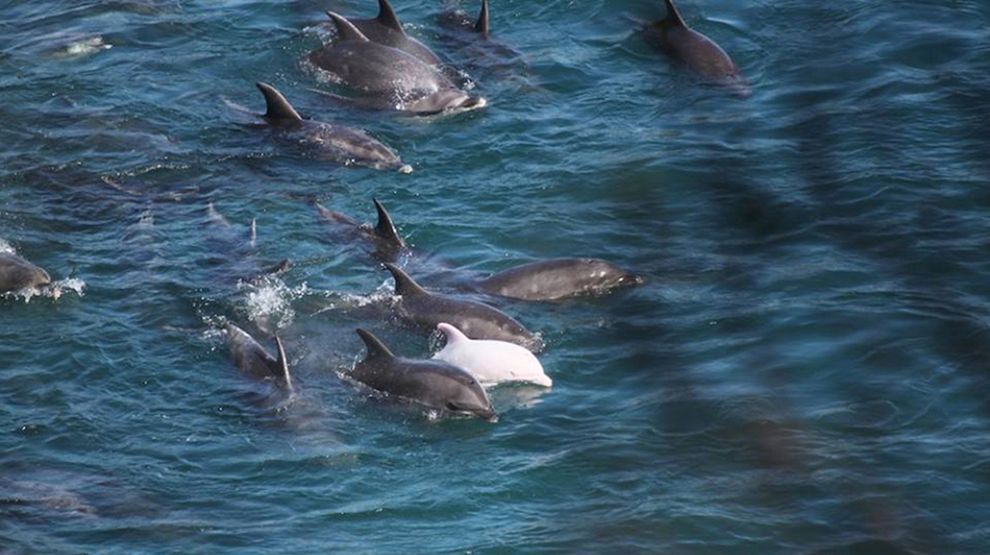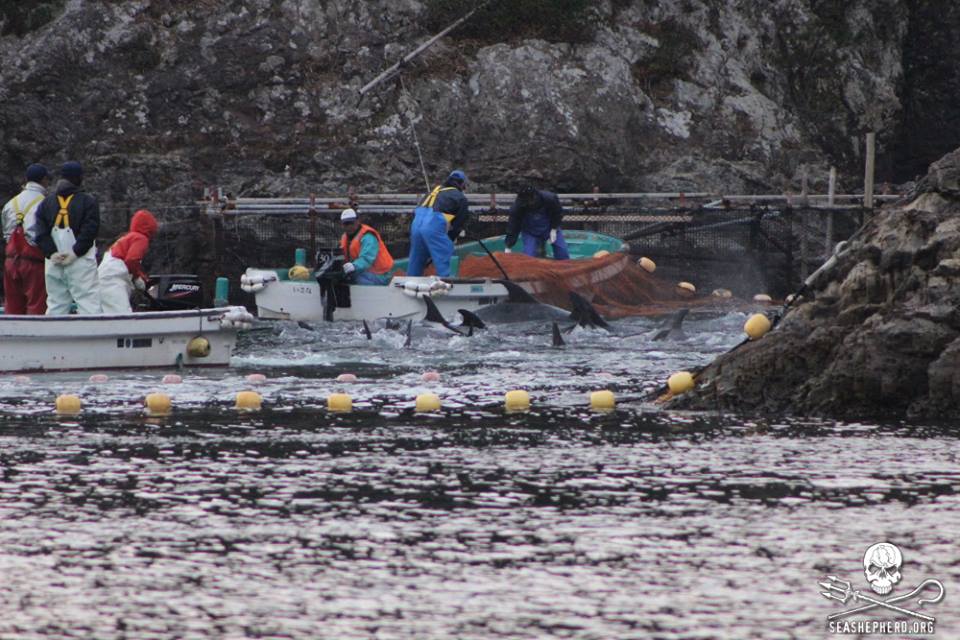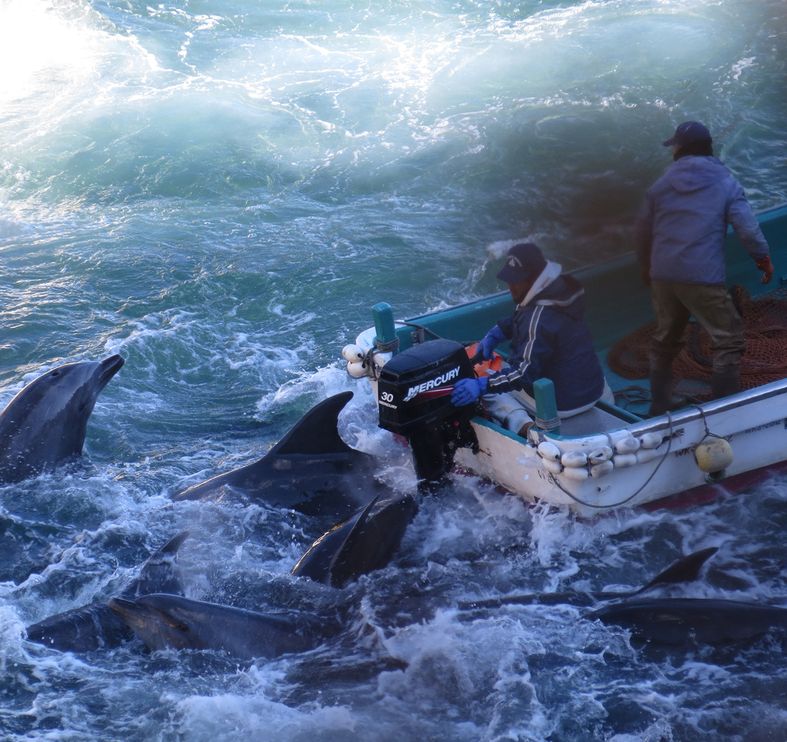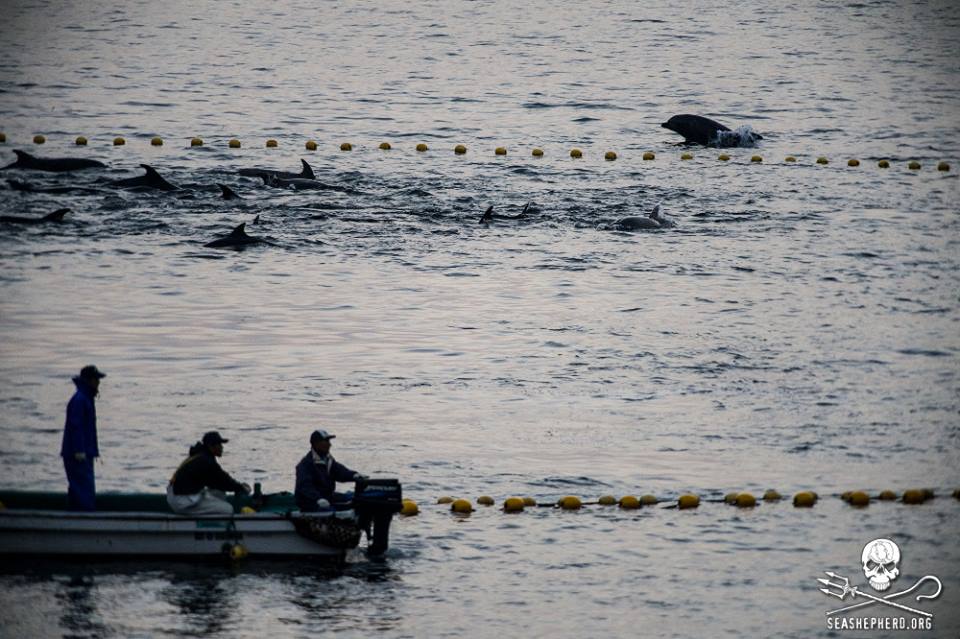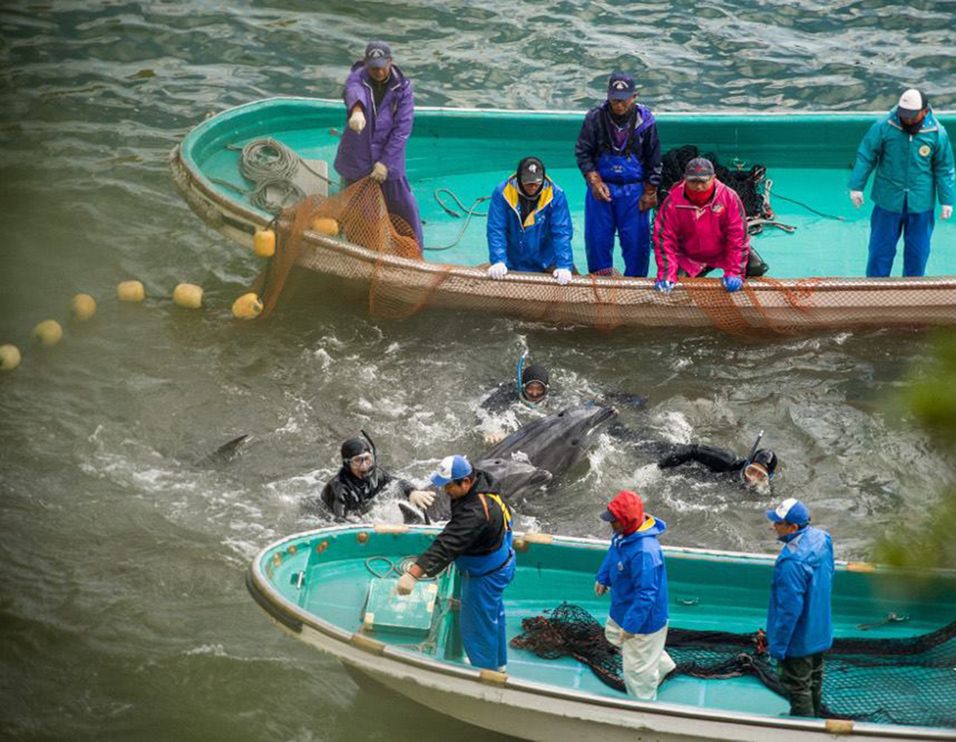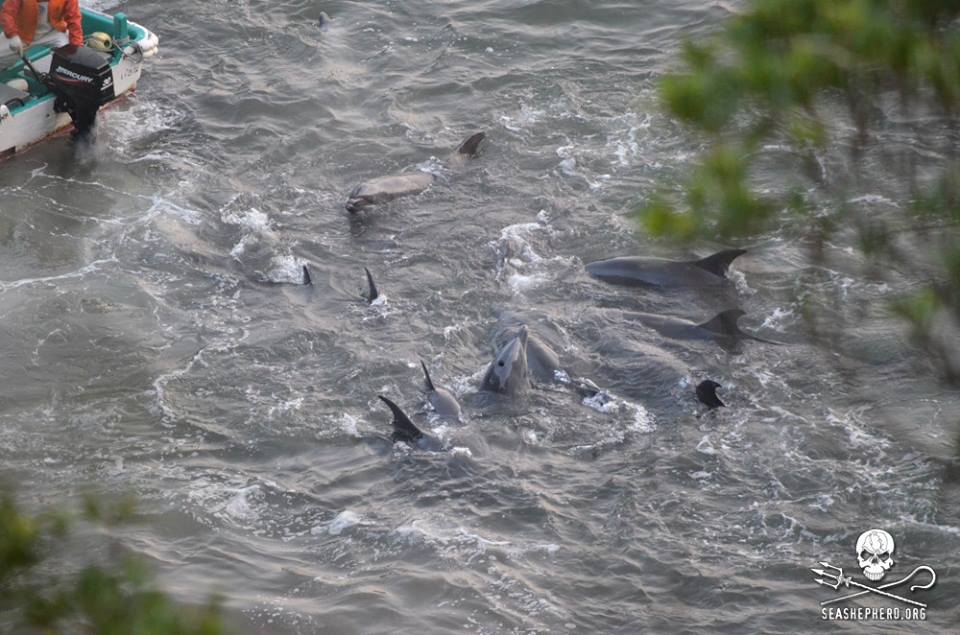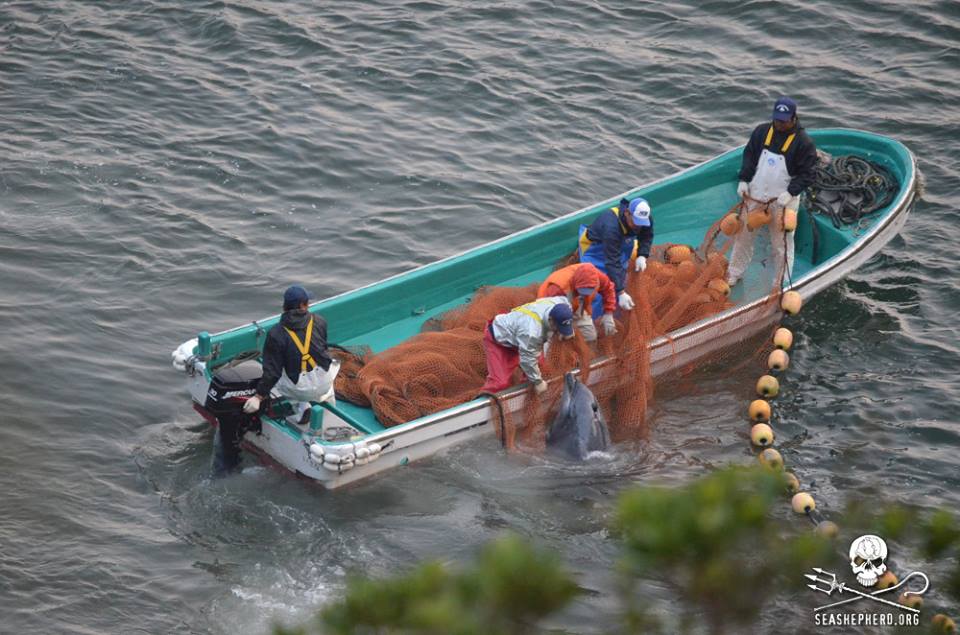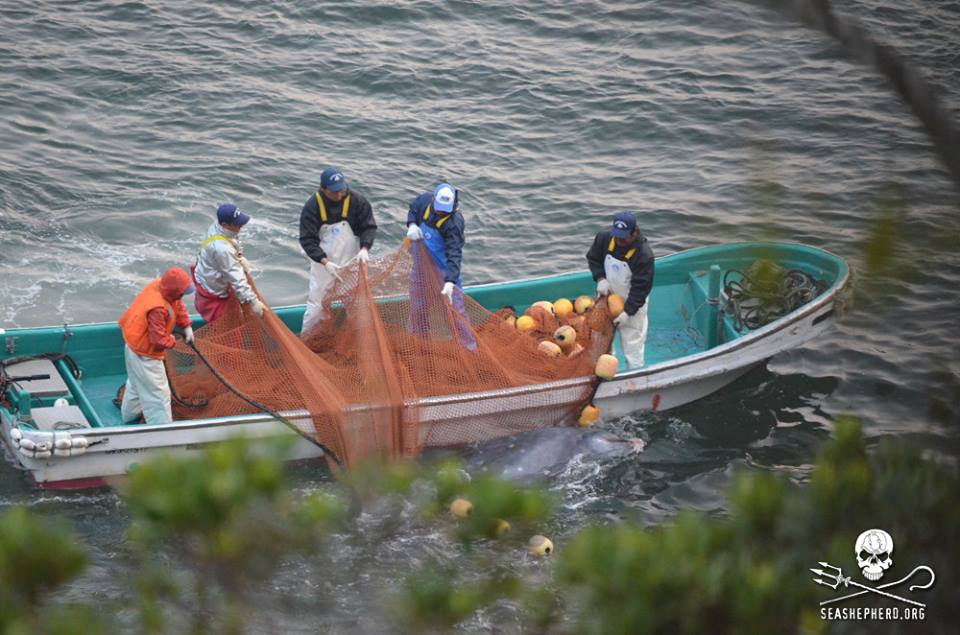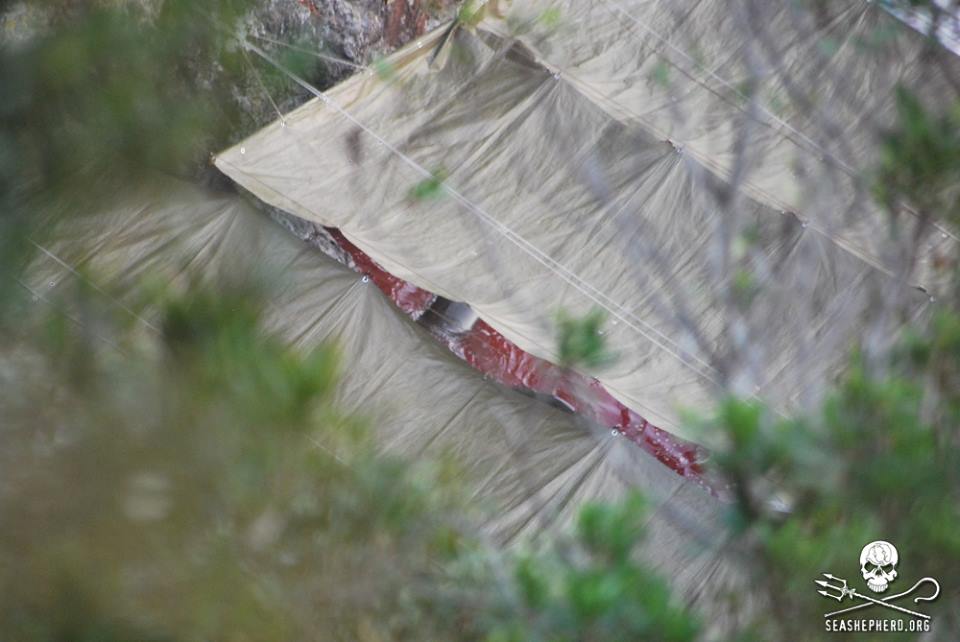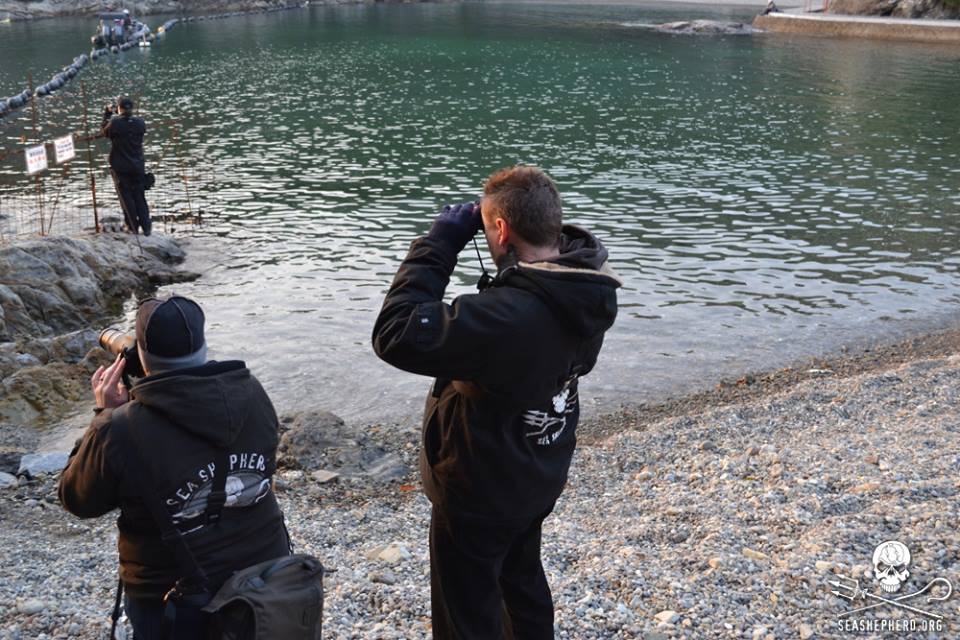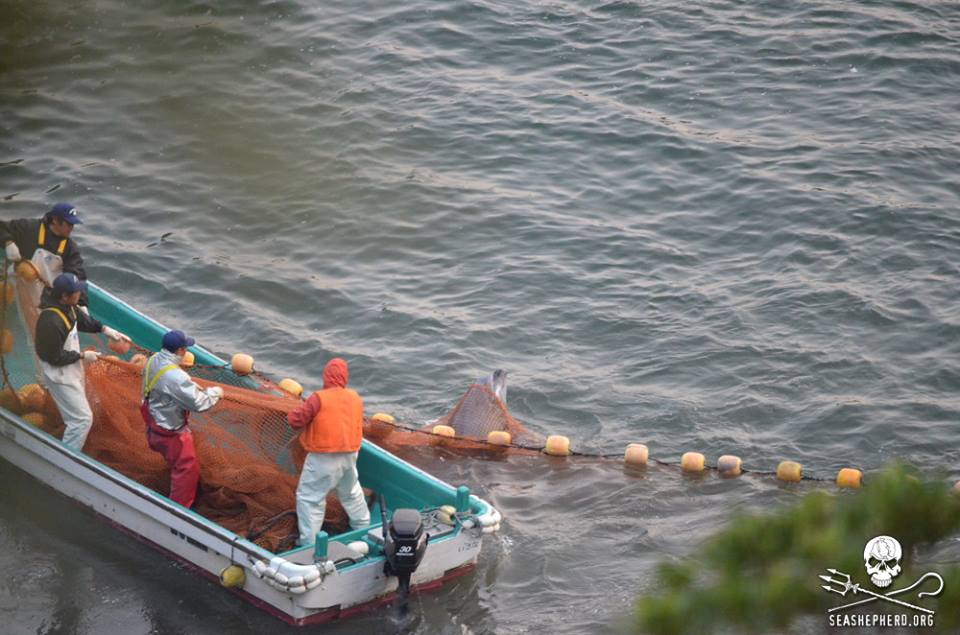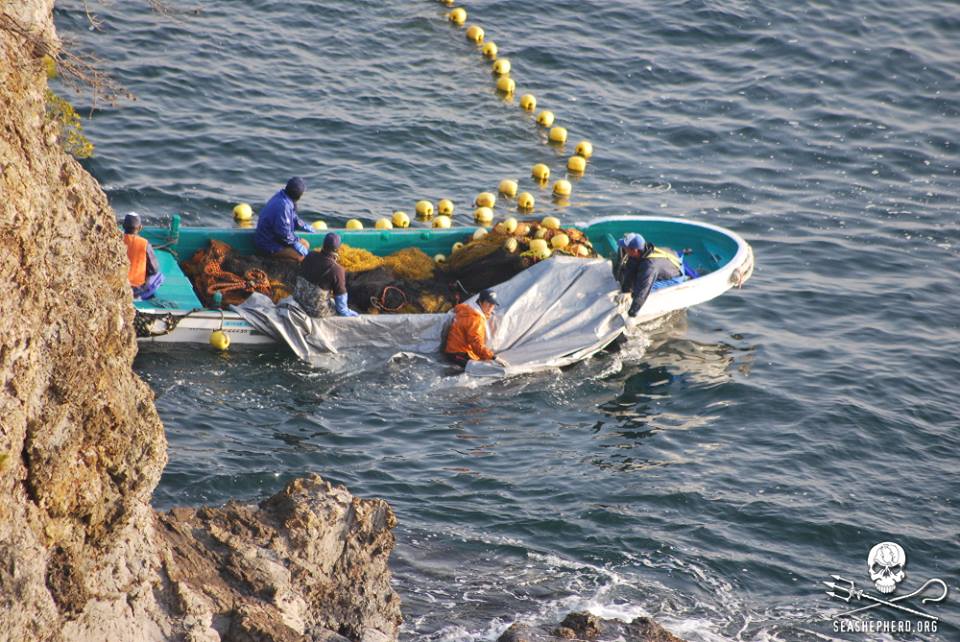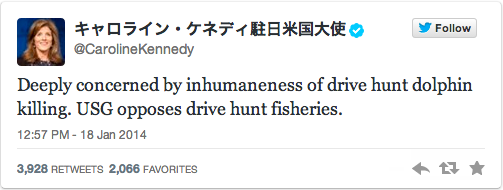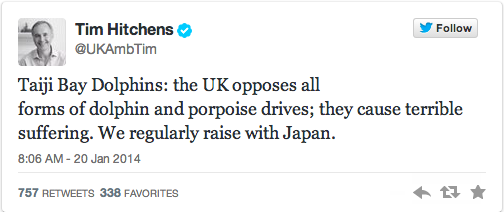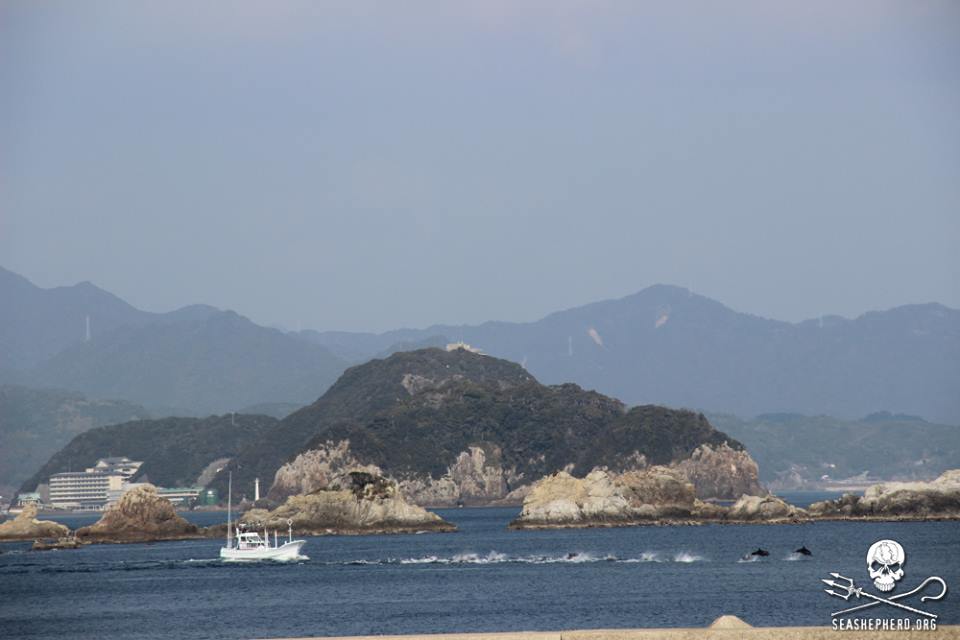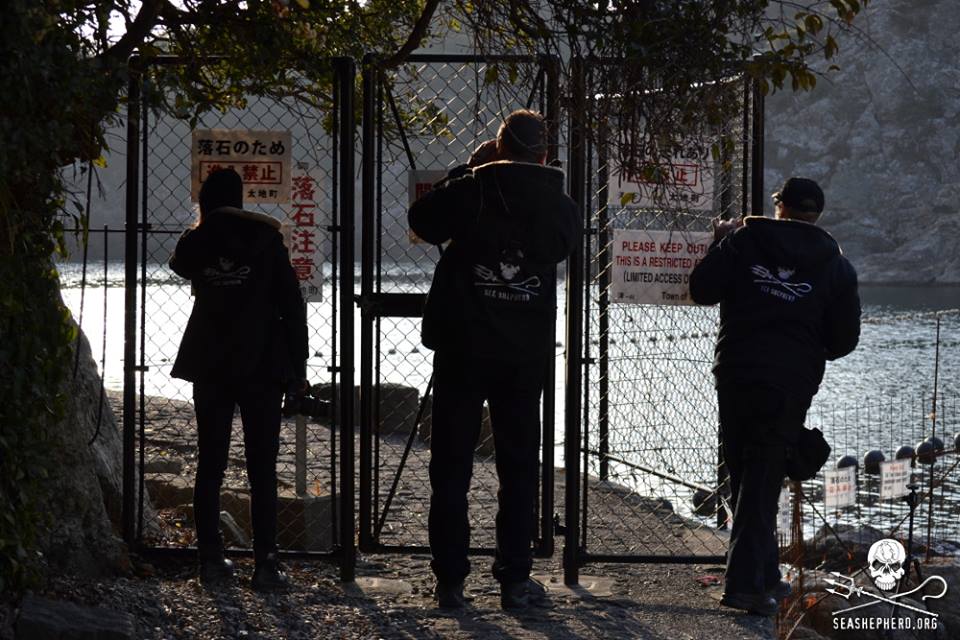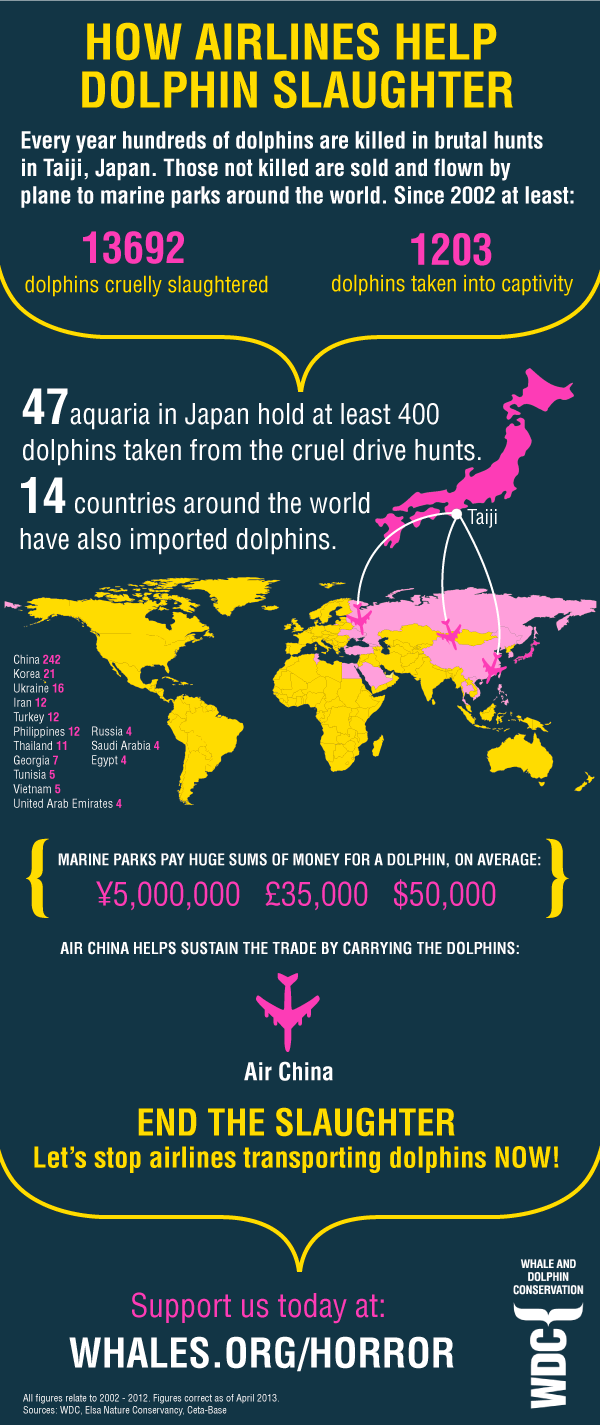[PHOTOS] The Bloody Dolphin Massacre That Japan Is Trying To Hide From The World
A total of 93 wild dolphins have been forcibly removed from the seas of Japan in the annual Taiji cove hunt this 2014. About 150 more dolphins were released back into the bloody waters, but might not survive in the days to come to due to the injuries that the fishermen have harshly inflicted upon them.
Japanese Fisherman Have Started Their Controversial Annual Slaughter Of Dolphins In The Taiji Cove On 21 January 2014
Fishermen in Japan began slaughtering hundreds of bottlenose dolphins early on Tuesday morning, campaigners said, despite mounting international calls for the animals to be spared.
Remaining pod swimsjust a few feet from the slaughter of their family.
Image via Sea Shepherd Cove Guardians Page (official)Every year the fishermen of Taiji, in western Wakayama prefecture, drive hundreds of dolphins into a cove, select some for sale to marine parks, release some and kill the rest for meat.
yahoo.comThe Numbers Vary, But Activist Group Sea Shepherd Estimates About 42 Out Of 250 Dolphins Have Been Killed This Week For Human Consumption.
Five separate pods of Bottlenose dolphins totaling more than 250 individuals—including juveniles and babies—were driven into Taiji’s infamous killing cove on Thursday, where they have endured four days of a bloody and traumatizing captive selection process.
 ecowatch.com
ecowatch.com
For the fifth straight day the killers of Taiji, Japan inflicted further pain and suffering on 42 of the 250 Bottlenose dolphins that were herded into the cove.
 facebook.com
facebook.com
Traditionally, the Japanese drive hunts were mainly as a way of procuring meat. Dolphin meat has long been considered a local Taiji delicacy, and meat from the Taiji dolphin hunt has been sold across Japan. Hunting whales and dolphins was also a mainstay of the Taiji economy.
Another 51 Dolphins, Including A Rare Albino Calf, Have Also Been "Reserved" To Be Sold To Aquariums And Water Parks. A Total Of 93 Dolphins Have Been Forcibly Removed From The Sea.
More than 50 of the mammals, including a rare albino calf, were selected and removed from the pod for sale to aquariums and water parks. Together they are expected to fetch millions of dollars.
Hungry from killing up an appetite, the dolphin murderers took a break for lunch before the remaining 130-140 starved and injured Bottlenose dolphins were driven back out to sea in the same deafening manner as the drive in. Many of these dolphins who were driven out will not survive and will soon be found washed ashore in the coming days.
 facebook.com
facebook.com
Every Year, Hundreds Of Dolphins Will Be Wrangled And Wrestled Into The Cove. Fishermen Will Confuse The Dolphin's Hypersensitive Sonars By Banging Metal Poles Under The Water.
Fishermen waiting in the shallow waters by the shore, some in wet suits with snorkeling masks on their faces, wrestled the dolphins into submission and tied their tails with ropes to stop them from escaping.
yahoo.comFishermen bang metal poles together beneath the water to confuse the animals’ hypersensitive sonar before herding them into shallow water, where they are left for up to several days before being taken to the cove to be slaughtered.
Dolphins repeatedly became entangled in the nets in their frantic efforts to escape or get to separated family members, the nets cutting through their flesh.
 ecowatch.com
ecowatch.com
The Bottlenose pod was so exhausted that they did not put up much of a fight while being herded toward the tarps.
Image via Sea Shepherd Cove Guardians Page (official)Fishermen Will Then Slaughter The Dolphins By Running Them Over With Small Boats And Ramming Metal Poles Into Their Blowholes To Rupture Their Spinal Cords
Fishermen herd entire cetacean families into shallow bays where they are mercilessly stabbed with a metal spike inserted into their blowhole to sever their spine.
 ecowatch.com
ecowatch.com
"A metal rod was stabbed into their spinal cord, where they were left to bleed out, suffocate and die. After a traumatic four days held captive in the killing cove, they experienced violent captive selection, being separated from their family, and then eventually were killed today," Sea Shepherd Conservation Society activist Melissa Sehgal told Reuters.
yahoo.comOne lone dolphin was seen swimming on the outside of the net. This dolphin continued to linger with family that was trapped in the killing cove. One dolphin died after attempting to make it to the other side, but only becoming entrapped within the nets.
Image via Sea Shepherd Cove Guardians Page (official)The Mammals Are Then Left To A Long, Slow And Painful Death As They Bleed Out, Suffocate, Or Drown While They Are Being Dragged To The Butcher
"It takes up to 20 to 30 minutes for these dolphins to die, where they bleed out, suffocate or drown in the process of being dragged to the butcher house," Sehgal said. They are then taken by boat to a quayside warehouse to be cut up into slabs of meat.
40 dolphins were callously murdered toaday in the cove. One dolphin drowned within nets while trying to escape. A total body count of 41 dolphins.
Image via Sea Shepherd Cove Guardians Page (official)It Is Not Uncommon That The Sea Turns The Colour Of Deep Red From All The Dolphin's Spilled Blood. The Entire Process Takes About 4 Days.
A Bottlenose dolphin was seen floating on back before slaughter.
Image via Sea Shepherd Cove Guardians Page (official)It Is Not Uncommon That The Sea Turns The Colour Of Deep Red From All The Dolphin's Spilled Blood
Image via akamaihd.netThe dolphins slowly and painfully bleed to death or drown in the blood of their family. These inhumane killings would not be allowed in any slaughterhouse in the world.
 ecowatch.com
ecowatch.com
To Hide Their Act From Activists And Journalists, Fishermen Put Up A Blue Tarpaulin. They Also Shoved Corks Into The Dolphins' Blowholes To Prevent Blood From Spilling Into The Sea.
Cove Guardians Jac and Ian document the slaughter.
Image via Sea Shepherd Cove Guardians Page (official)The fishermen put up a blue tarpaulin that partially hid them from activists and journalists during the final, killing phase of the annual hunt that began on Friday, Reuters reports.
"Under the tarps in the shallows is where the trainers work with the killers to select the 'prettiest' dolphins which will sell and make the best pay day for the hunters," said the Sea Shepherd Conservation Society.
cnn.comAccording To The Whale and Dolphin Conservation, An Estimated 18,000 Dolphins Have Been Killed Or Taken Into Captivity During The Taiji Hunt Since 2000
Since 2000, according to the group Whale and Dolphin Conservation, more than 18,000 dolphins from seven different species have been either killed or taken into captivity during the Taiji hunt.
A remaining pod of aprroximately 130-140 dolphins were left to witness their family slaughtered.
Image via Sea Shepherd Cove Guardians Page (official)Japan Has Received Widespread Condemnation From NGOs And People All Over The World For Their Controversial Culling On An Endangered Species
In an open letter to the people of Taiji released Monday, the Japanese artist and peace campaigner Yoko Ono called for an end to the cull. "I understand how you must feel about the one-sidedness of the west to be angry at your traditional capture and slaughter of dolphins," she wrote. She wrote: "The future of Japan and its safety depends on many situations, but what you do with dolphins now can create a very bad relationship with the whole world."
But the hunt is heavily scrutinized by environmental activists, who have been monitoring activities and livestreaming and tweeting about the latest developments.
cnn.comHowever, They Refuse To End The Capture And Slaughter Of Dolphins As It Is Considered A Traditional Practice Of The People
Meat buyer trucks lined up atthe back entrance to the butcher house.
Image via Sea Shepherd Cove Guardians Page (official)Japan refuses to sign on to many protection efforts and regulations for marine mammals, despite most of the world recognizing the need to protect these imperiled animals. The most well-known among these annual hunts occurs in Taiji from Sept. 1 and usually continues through March of the following year.
 ecowatch.com
ecowatch.com
“We are a whaling community, and we don’t want to lose that,” Katsutoshi Mihara, chairman of Taiji’s town council, told the New York Times in 2008. “Here, all boys grew up dreaming of hunting whales.”
Tne Japanese fishing industry official told Agence France Presse: “We’ve got our lives. We can’t simply nod (to protests) and end centuries of our tradition… If you want to talk about cruelty, you couldn’t eat cows, pigs or any other living creatures.”
Japan’s Chief Cabinet Secretary, "I Believe Dolphin Fishing Is One Of Japan's Traditional Fishing Industries And Is Carried Out Appropriately In Accordance To The Law.”
On Monday, Japan’s chief cabinet secretary defended the hunt. "I believe dolphin fishing is one of Japan's traditional fishing industries and is carried out appropriately in accordance to the law,” Suga told reporters when asked about Kennedy’s comments.
“Furthermore, dolphins are not within the management of the International Whaling Commission and it is left to the respective nations to manage this resource.
The drive out is just as traumatic as the drive in. Dolphins linger to find family.
Image via Sea Shepherd Cove Guardians Page (official)Japanese Fishermen Believe That The Hunt Provides Crucial Source Of Income And Helps Maintain Fish Stocks In The Area
"Dolphin fishing is one of traditional fishing forms of our country and is carried out appropriately in accordance with the law. Dolphin is not covered by the International Whaling Commission control and it's controlled under responsibility of each country."
cnn.com"We have fishermen in our community and they are exercising their fishing rights," he said. "We feel that we need to protect our residents against the criticisms."
cnn.comThe dolphin killers are notorious for running over the pod with skiffs and many dolphins suffer multiple injuries from propellers.
Image via Sea Shepherd Cove Guardians Page (official)However, Activists Could Not Disagree More. "The Dolphin Hunts Are Being Used By Captivity Industry To Supply Wild Dolphins To Aquariums All Around The World."
Cove Guardians bear witness to 40 dolphins being slaughtered.
Image via Sea Shepherd Cove Guardians Page (official)“This claim of ‘Japanese tradition’ is nonsense,” said Ric O’Barry, a former dolphin trainer who is now director of Earth Island’s dolphin project. “The dolphin drive hunts, according to the town’s own written history, says a couple of drive hunts occurred in 1936 and 1944, but the current series of hunts only began in 1969.
“The dolphin hunts are being used by the captivity industry to supply wild dolphins to aquariums in Japan, China, Dubai, and other aquariums all around the world.”
“The sale of dolphins is what keeps it going. That is the economic underpinning of the slaughter,” he says. “I don’t think selling dolphin meat would be profitable anymore. It’s all about money, lots of money.”
The World Took Notice Of The Practice After An Exposé By 2009 Oscar-Winning Documentary 'The Cove'
The World Took Notice Of The Practice After An Exposé By 2009 Oscar-Winning Documentary 'The Cove'
Image via filmmakermagazine.comA 2009 Oscar-nominated documentary film, "The Cove," brought the issue of dolphin hunting in Taiji to the fore with bloody scenes of dolphin slaughter.
cnn.comThe prefecture government has condemned the film in an online response as distorted, biased and unfair to the fishermen. "'The Cove' filmed secretly the scenes of dying dolphins, and depicted their death in a manner designed to excite outrage," according to the Wakayama Prefecture statement.
cnn.comWhale And Dolphin Conservation Have Started An Online Petition To End The Practice Of Dolphin Slaughter. CLICK On Link To Sign The Petition.
Dolphins captured during the brutal drive hunts in Japan are being flown out to marine parks around the world by commercial airlines. Please help us to end this once and for all. [CLICK On Link To Sign The Petition]
whales.org


